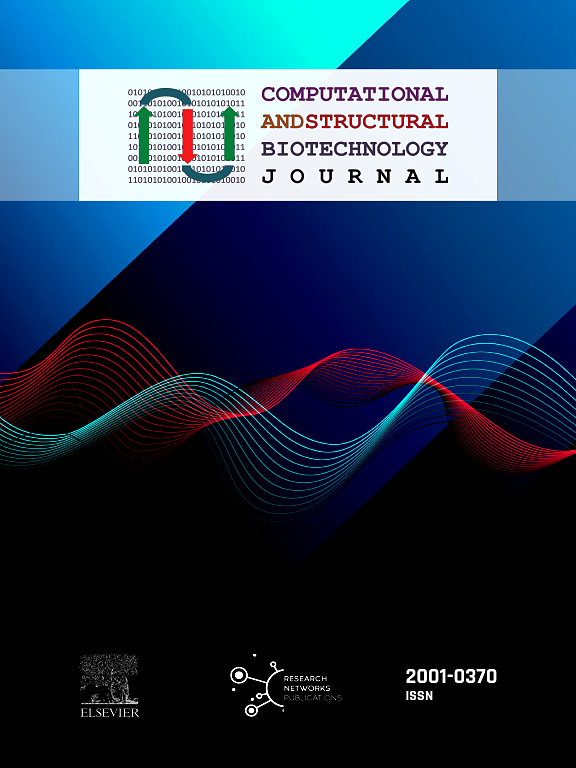两种耐酸大环素 O-甲基转移酶变体的产生和特征描述:30 °C时,来自弗氏链霉菌的两种变体具有更高的酶活性
IF 4.4
2区 生物学
Q2 BIOCHEMISTRY & MOLECULAR BIOLOGY
Computational and structural biotechnology journal
Pub Date : 2024-08-22
DOI:10.1016/j.csbj.2024.08.020
引用次数: 0
摘要
泰乐菌素是一种重要的大环内酯类抗生素。在泰乐菌素的生物合成过程中,大观霉素甲基转移酶 TylF 催化副产品泰乐菌素 C(大观霉素)向主要成分泰乐菌素 A 的转化(C/A 转化)。这种转化是泰乐菌素生物合成过程中的限速步骤,会影响最终产品的质量。为了找到高活性、适应环境的 TylF 酶,我们在之前的研究(Fan 等,2023 [41])中通过蛋白质进化方法构建了一个 TylF 变体池。本研究表达并纯化了具有较高 C/A 转化率的 TylF 变体。结果表明,变体 TylF、TylF 和 TylF 在 30 °C 时的 C/A 转化率高于 TylF 在 38 °C 时的 C/A 转化率。此外,它们具有更强的耐酸性,对发酵过程中的 pH 值变化也有更强的适应性。进一步的蛋白质结构和底物结合亲和力分析表明,T36S、V54A、Q138H、Y139F 和 F232Y 突变扩大了底物结合口袋的容积,从而提高了酶变体对底物 SAM 和大环内酯的亲和力,降低了对 SAH 的抑制作用。在工业化生产的泰乐菌素菌株中过表达了三个 TylF 变体,重组菌株在发酵的最后 24 小时内无需加热至 38 °C,即可在 30 °C下显示出最高的 C/A 转化率。这对泰乐菌素的工业化生产具有重要的节能意义。本文章由计算机程序翻译,如有差异,请以英文原文为准。
Generation and characterization of two acid-resistant macrocin O-methyltransferase variants with a higher enzyme activity at 30 °C from Streptomyces fradiae
Tylosin is an important macrolide antibiotic produced by . In the biosynthesis of tylosin, macrocin -methyltransferase TylF catalyzes the conversion of the side-product tylosin C (macrocin) to the primary component tylosin A (C/A conversion). This conversion is the rate-limiting step in the biosynthesis of tylosin, and affects the quality of the end product. To find a high activity and environment-adapted TylF enzyme, a TylF variant pool has been constructed protein evolution approach in our previous study (Fan et al., 2023 [41]). In this study, the TylF variants with higher C/A conversion rates were expressed in and purified. The variants TylF, TylF and TylF were shown to have a higher C/A conversion rate at 30 °C than that of TylF at 38 °C. Moreover, they had a greater acid resistance and showed more adaptable to the pH change during fermentation. Further protein structural and substrate-binding affinity analyses revealed that the T36S, V54A, Q138H, Y139F, and F232Y mutations enlarged the volume of the substrate-binding pocket, thereby increasing the affinity of enzyme variants for their substrates of SAM and macrocin, and decreasing the inhibition of SAH. Three of the TylF variants were overexpressed in the industrial tylosin-producing strain, and the recombinant strains showed the highest C/A conversion at 30 °C without heating up to 38 °C during the last 24 h of fermentation. This is of great energy-saving significance for tylosin industrial production.
求助全文
通过发布文献求助,成功后即可免费获取论文全文。
去求助
来源期刊

Computational and structural biotechnology journal
Biochemistry, Genetics and Molecular Biology-Biophysics
CiteScore
9.30
自引率
3.30%
发文量
540
审稿时长
6 weeks
期刊介绍:
Computational and Structural Biotechnology Journal (CSBJ) is an online gold open access journal publishing research articles and reviews after full peer review. All articles are published, without barriers to access, immediately upon acceptance. The journal places a strong emphasis on functional and mechanistic understanding of how molecular components in a biological process work together through the application of computational methods. Structural data may provide such insights, but they are not a pre-requisite for publication in the journal. Specific areas of interest include, but are not limited to:
Structure and function of proteins, nucleic acids and other macromolecules
Structure and function of multi-component complexes
Protein folding, processing and degradation
Enzymology
Computational and structural studies of plant systems
Microbial Informatics
Genomics
Proteomics
Metabolomics
Algorithms and Hypothesis in Bioinformatics
Mathematical and Theoretical Biology
Computational Chemistry and Drug Discovery
Microscopy and Molecular Imaging
Nanotechnology
Systems and Synthetic Biology
 求助内容:
求助内容: 应助结果提醒方式:
应助结果提醒方式:


